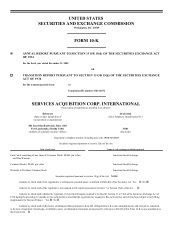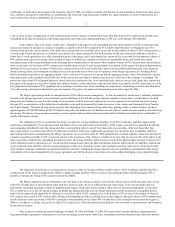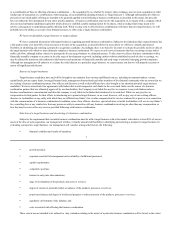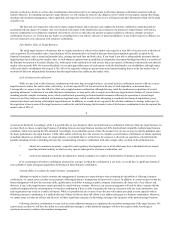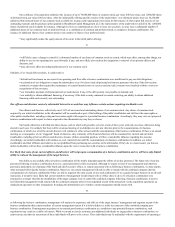Jamba Juice 2006 Annual Report Download - page 5
Download and view the complete annual report
Please find page 5 of the 2006 Jamba Juice annual report below. You can navigate through the pages in the report by either clicking on the pages listed below, or by using the keyword search tool below to find specific information within the annual report.
cash flow businesses that leverage scale and a specific expertise to provide better service and value at a cheaper “all-in” cost than customers could provide by
themselves. We believe that businesses that leverage scale generally have a fixed cost base, underlying technology platform, brand name, corporate
organizational structure or other similar operating characteristic or asset which may be utilized or spread over a larger revenue base or a large number of
customers, thereby, in theory, increasing the profitability percentage of the business. Examples include transaction / payment processing, technology services,
customer service/relationship management, warranty management, document management, back-office services (accounting, payroll, human resource
administration, benefits processing, etc.), training and compliance services, security services and alarm monitoring, facilities services (including waste
disposal, pest/lawn control, landscaping maintenance services and commercial cleaning), and service franchising businesses.
5
Health Care Services
Health care spending in the United States was nearly $1.7 trillion in 2003 and for the first time exceeded 15% of the Gross Domestic Product according to
recently released data from the Center for Medicare & Medicaid Services, Office of the Actuary. The total market is comprised of numerous large, often multi-
billion dollar niche markets that span all aspects of healthcare, with “services” (payments to physicians, hospitals, and other providers) accounting for more
than $1.0 trillion of total spending. Moreover, according to the same study, health care spending is expected to grow more than $3.3 trillion and represent in
excess of 18% of GDP by 2013.
We believe that significant challenges will continue to confront the health care industry, driven primarily by the changing roles/relationships among
physicians, payors and patients. Thus, we will consider those companies that reduce the cost or improve the quality of care in traditional settings, such as
doctors’ offices or hospitals, or provide quality, low-cost options that are designed to encourage customers to utilize the services because of factors such as cost
and/or convenience.
We are particularly interested in companies that will accelerate the movement of care out of the general hospital setting and into more focused, less
expensive alternative locations. Characteristics we find particularly attractive include (i) focus on a defined patient group and their specific clinical needs;
(ii) emphasis on delivering care in a high-volume, low-cost, patient friendly setting; (iii) recognition by providers and payors of the medical necessity of the
service; and/or (iv) a more convenient, cost-effective, and higher quality setting for clinicians and patients. Examples include specialty care surgical centers,
out-patient triage or urgent care clinics, chronic disease treatment centers and product distribution companies.
Additionally, we will consider those companies that offer non-core support and administrative services. These companies, which typically focus on
excelling in a narrowly defined discipline, are typically less expensive yet offer higher quality service than providers and payors traditionally procure for
themselves internally. Examples include billing services, electronic medical records, specialty group practice management, insurance/risk retention, third-party
administrators, nurse staffing, and health related member benefit programs.
Consumer Services
This group includes branded consumer products and services. We believe that certain companies that are focused on creating a brand (e.g. Nike,
Starbucks, etc.) as opposed to delivering services under generic labels will continue to provide attractive investment opportunities. In addition, we believe that
companies that can attract and meet the growing needs and desires of the 78 million aging baby boomers born between 1946 and 1964, as well as the “Gen Y”
population born between 1979 and 1994, are attractive, particularly those with an emphasis on providing “health and wellness” alternatives to the customer.
As with Business Services, we are focused on those companies that can build a lasting relationship with the consumer that yields predictable, recurring
revenue that does not fluctuate dramatically from fiscal period to period. Examples include health clubs, spa services, hair salons, pest control, alarm
monitoring, and home warranty contracts.
Transaction Structures
We believe the majority of the transactions we will review and consider fall into the following categories:
Growth Scenarios —situations where companies have the opportunity for organic growth through market development, incremental marketing, or
increases in working capital.
Industry Consolidations —opportunities in fragmented industries, or new emerging markets, in which revenue growth is driven, and operating expenses
are leveraged, in large part via strategic acquisitions.
Divisional Spin-outs —operating units of larger companies that are profitable but have been neglected by the parent in terms of focus, resources or
funding.
6
General
We are not presently engaged in, and if a suitable business target is not identified by us prior to the prescribed liquidation of the trust fund we may
not engage in, any substantive commercial business. We intend to utilize cash derived from the proceeds of our initial public offering, our capital stock, debt

